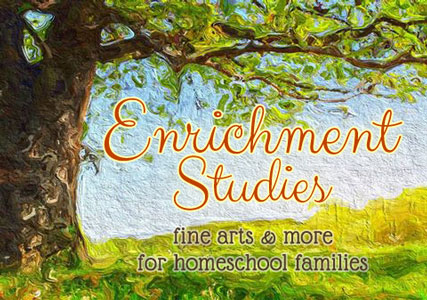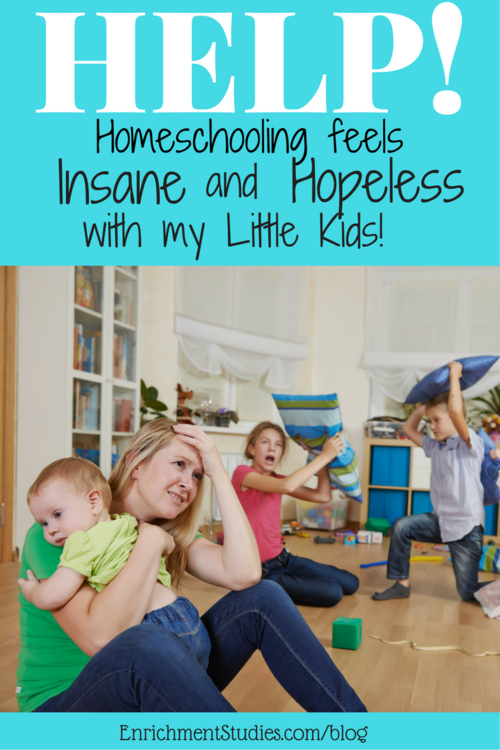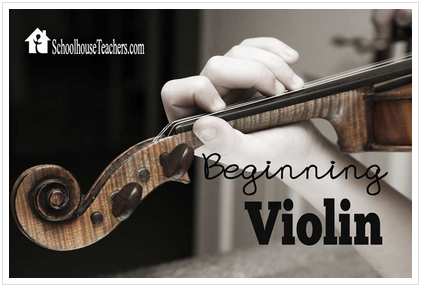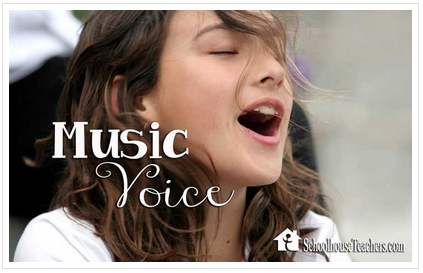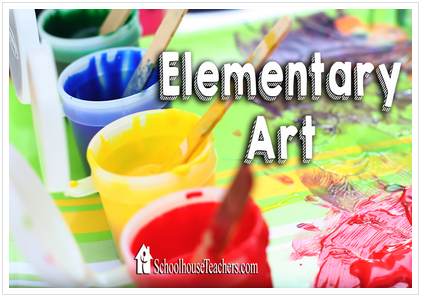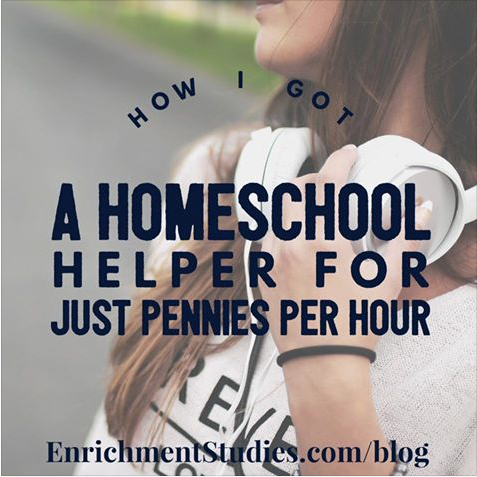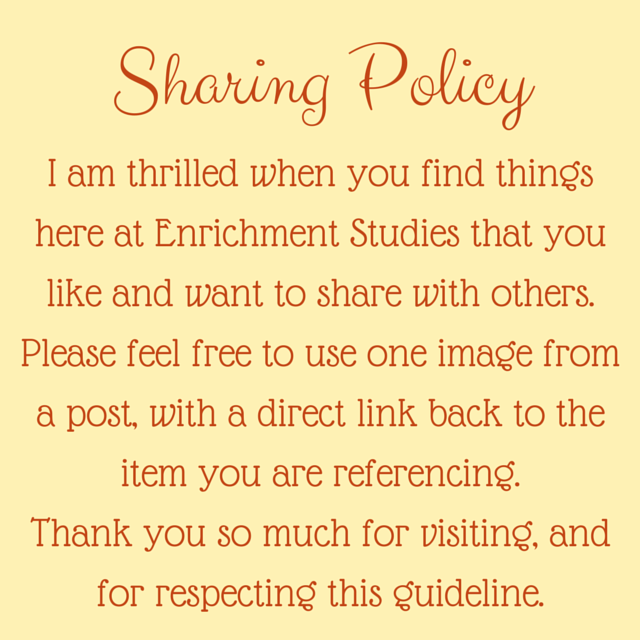by Erica Johns | Mar 16, 2019 | Art, Freebies
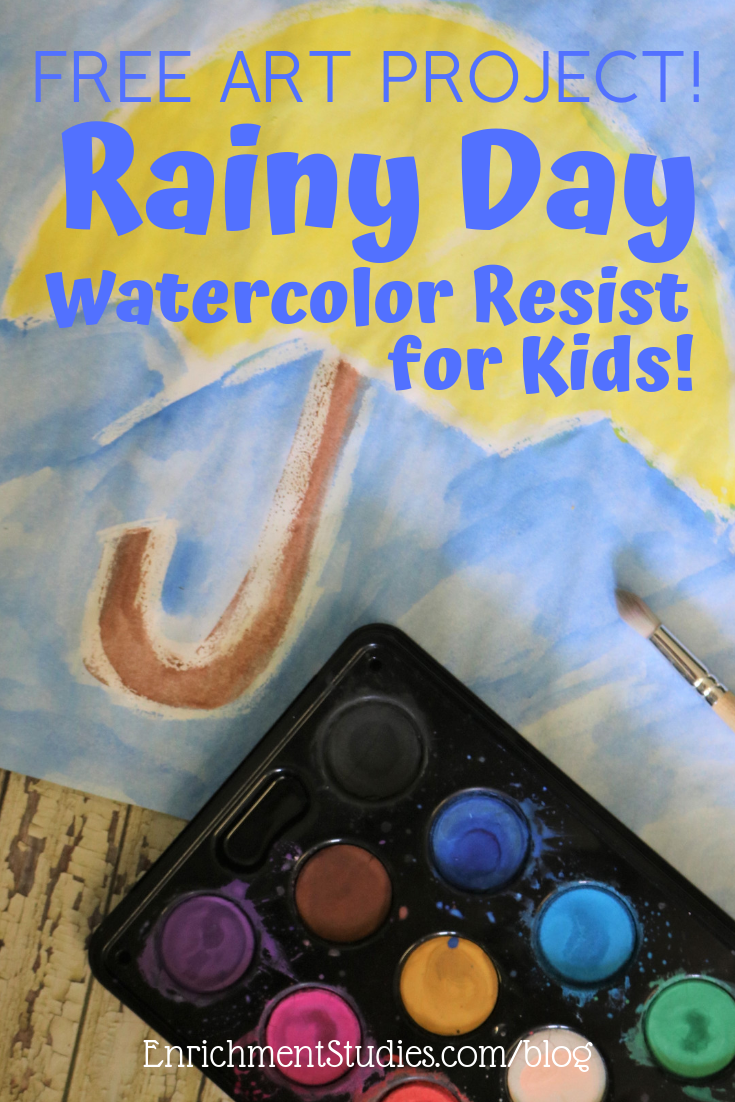 If you have done art with kids at all, whether it be to a group, or to your own kids for homeschool art, or just as a fun activity, watercolors are something you have probably done more than once. Kids learn to use them at a very young age and because of the way they are packaged, all neat and dry in their own little containers, they make it easy to transport and use other places, too. You just need some watercolor paper, water and a brush, and you’ve got something fun to do.
If you have done art with kids at all, whether it be to a group, or to your own kids for homeschool art, or just as a fun activity, watercolors are something you have probably done more than once. Kids learn to use them at a very young age and because of the way they are packaged, all neat and dry in their own little containers, they make it easy to transport and use other places, too. You just need some watercolor paper, water and a brush, and you’ve got something fun to do.
For this project, the only other thing you need is a white crayon!
Watercolor resist is a technique where you draw a fairly simple design on your paper first, and the wax from the crayon “resists” the water and paint pigment, creating a neat look that is a magical thing to watch, too, so kids really enjoy it.
For this specific artwork, I was thinking for a rainy day activity, or during the summer when it can tend to be umbrella season, but truly, it is good for anytime. Amazon affiliate links have been used for some of the recommended supplies.
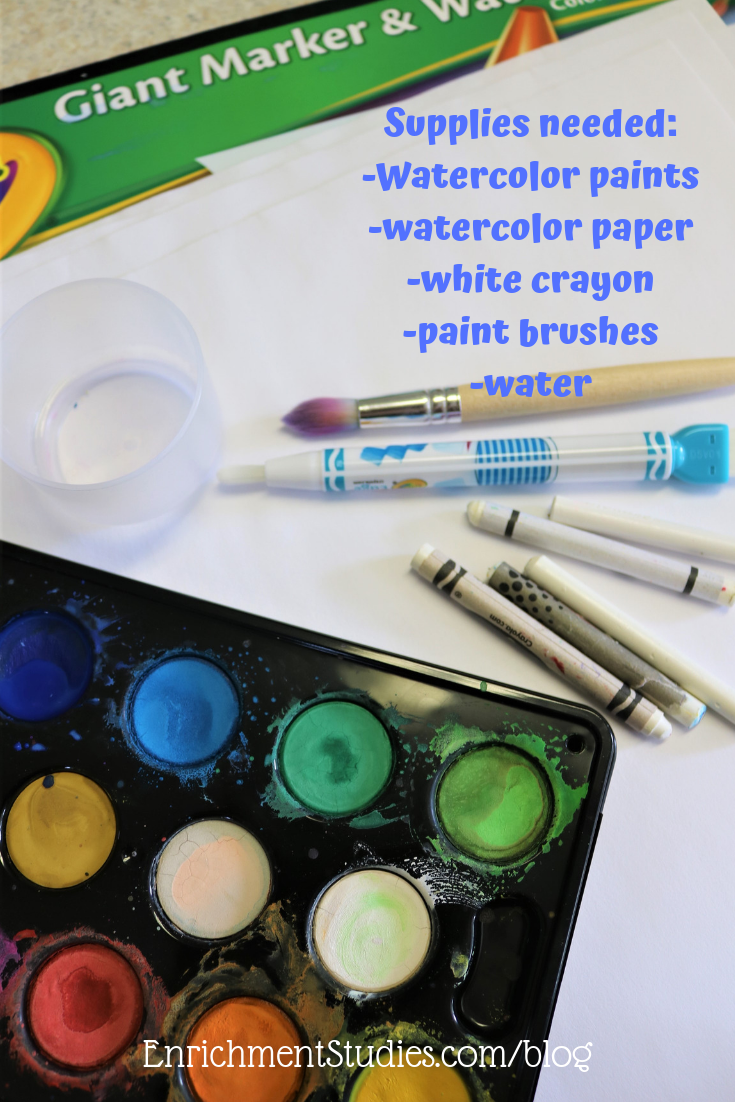 What you will need:
What you will need:
Watercolor paper: Yes, it really does make a difference to have the right paper. Regular paper gets soggy, rips and tears, and crinkles up when drying. Watercolor paper will give a much better outcome. One or two sheets per child.
Watercolor paints: I love this set for the vibrant colors, good coverage, and quality. SO much better than cheapie sets.
Brushes: A medium to large brush and a small brush for each child. I recommend this set of brushes because of the amount, variety of sizes, and quality.
White crayon – 1 per child
Cup of water and paper towels for each child
Hand wipes or a damp washcloth
Directions:
- Drawing the design: First thing, depending on the age of the kids, you may want to pre-draw the outline of the umbrella design for them with the white crayon. For kids maybe 3rd grade and under, this helps them get to experience the “magic” of seeing the white outline pop through the paint.Middlers (like 3rd-5th grade) may enjoy doing it once with you pre-drawing, and then a second time on their own once they’ve learned the technique. For older kids who you feel can design their own artwork easily, give them the crayons first and allow them to draw their own and then paint it. You can give them the theme of rainy day – I gave them summer rain, or something like that and they all came up with neat weather related paintings. It doesn’t have to be an umbrella. 🙂

This is a very poorly done outline of what the white crayon design should be like on your paper. #humble
The crayon is a little hard to see when you begin, but if you tilt the paper in the light, it will reflect the light and it will be easier to see. Start out by drawing the umbrella top, since it is the most focal and large part of the painting, and go over the lines several times with the crayon. If you don’t make the lines nice and thick in crayon, it won’t resist the paint. Then, draw your handle and some rain drops in the same manner.
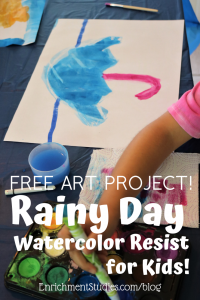 2. Painting: Now, give the kids the paints and brushes and water, and let them color in their umbrellas and skies. I told them to think “rainy day” or stormy type of skies, but I let them do it the way they wanted, and they all came out awesome.
2. Painting: Now, give the kids the paints and brushes and water, and let them color in their umbrellas and skies. I told them to think “rainy day” or stormy type of skies, but I let them do it the way they wanted, and they all came out awesome.
If they are newer to watercolors, they may try to make the paints thick, the way they are used to seeing acrylics or other mediums, and if they go too thick, the water won’t repel off the wax, so try to explain to them that you want strong color, but you do need it to be wet and spread it around some, so the water shows through. I had a few who didn’t really grasp the concept and they painted it very thick, so hardly any white popped through. (They still painted beautiful pieces though!)
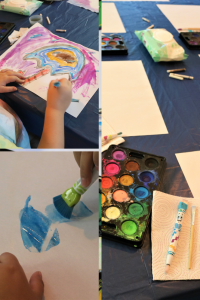

3. Drying: Once they are done with the watercolor paints, just allow them about 15 to 20 minutes to dry all the way.
Once you know how to make watercolor relief work, you can use it in lots of different ways!
by Erica Johns | Sep 1, 2017 | Art, Freebies
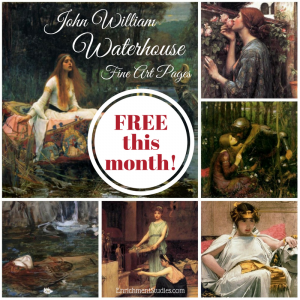 English painter John William Waterhouse is best-known for his portrayals of women in Greek mythology and Arthurian legend. This collection is one of my favorites for drawing together myth, literature, history, and art. You’ll find Cleopatra, The Lady of Shalott, Orpheus, damsels in distress, and more in this Fine Art Pages set.
English painter John William Waterhouse is best-known for his portrayals of women in Greek mythology and Arthurian legend. This collection is one of my favorites for drawing together myth, literature, history, and art. You’ll find Cleopatra, The Lady of Shalott, Orpheus, damsels in distress, and more in this Fine Art Pages set.
Currently you can get it FREE when you sign up at the right —>>> or click here.
by Erica Johns | Jun 1, 2017 | Art, Freebies
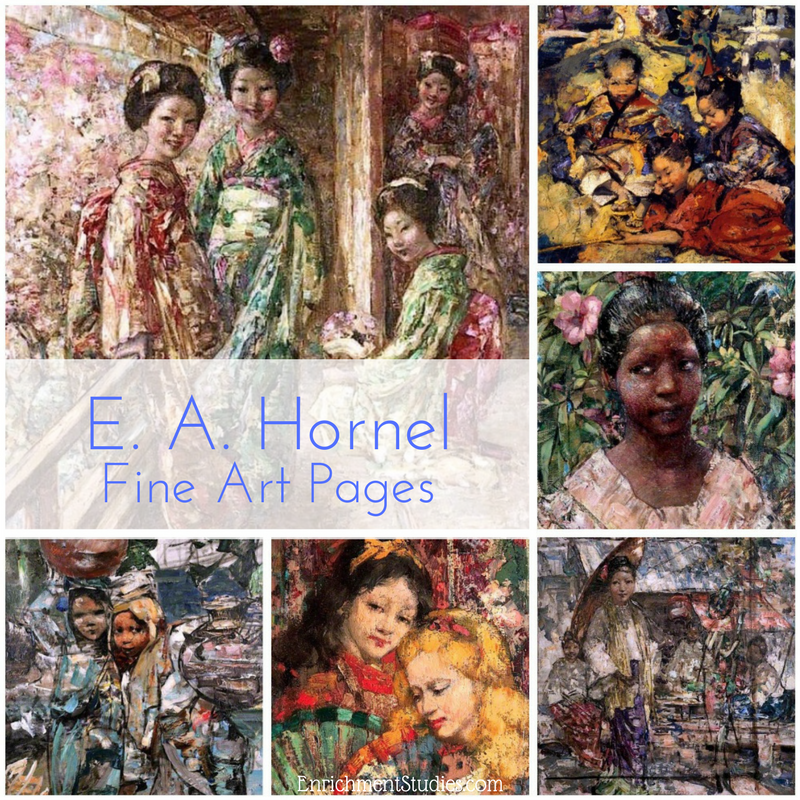 Edward Atkinson Hornel was a Scottish painter in the late 1800s/early 1900s that specialized in works depicting children in nature. This beautiful new collection includes ten of his works that feature girls from Japan, Burma, and Sri Lanka, among others. For families that desire to expose their children to more diversity in art, this is a wonderful collection to become familiar with. Hornel also has a very unique style of art that kids really respond to. His bold use of texture and many dashes of color is a technique that children can appreciate and try on their own! You can purchase this collection here.
Edward Atkinson Hornel was a Scottish painter in the late 1800s/early 1900s that specialized in works depicting children in nature. This beautiful new collection includes ten of his works that feature girls from Japan, Burma, and Sri Lanka, among others. For families that desire to expose their children to more diversity in art, this is a wonderful collection to become familiar with. Hornel also has a very unique style of art that kids really respond to. His bold use of texture and many dashes of color is a technique that children can appreciate and try on their own! You can purchase this collection here.
by Erica Johns | May 2, 2017 | Art, Freebies
 Fans of Impressionist art are going to be thrilled to see our new collection of works by famous French painter Berthe Morisot! Her timeless works are beloved around the world, and I trust your family will enjoy getting familiar with these paintings as well.
Fans of Impressionist art are going to be thrilled to see our new collection of works by famous French painter Berthe Morisot! Her timeless works are beloved around the world, and I trust your family will enjoy getting familiar with these paintings as well.
This month you can get this collection for FREE if you are a Subscriber Perks Member. Simply sign up to the right, or click here, and I’ll send you your coupon code right away! You’ll also receive my ebooklet How to Use Fine Art Pages in Your Home, which will help you get started with my best ideas right away.
by Erica Johns | Mar 13, 2017 | Art, Freebies, Language Arts
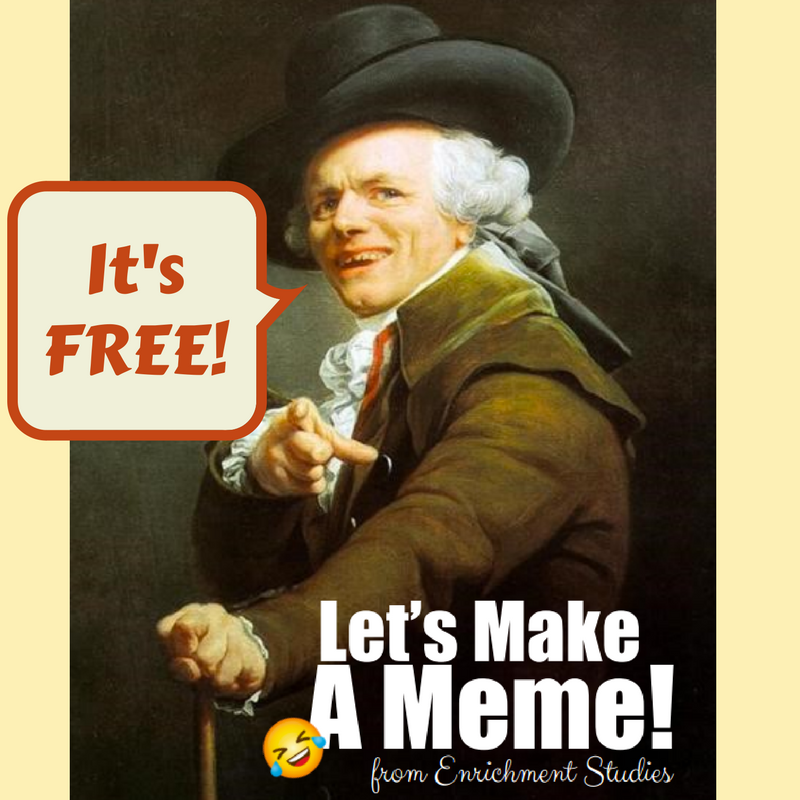 As a longtime homeschooling mother of six, I love it when I can find ways to connect different subjects in a way that my kids also enjoy. When I came across this hilarious, surprising, and fun art by Joseph Ducreux, I knew I wanted to bring it to you in a way that both showcased the timeless sense of humor that it embodies, while also inviting you and your family to interact with it. So, Let’s Make a Meme!
As a longtime homeschooling mother of six, I love it when I can find ways to connect different subjects in a way that my kids also enjoy. When I came across this hilarious, surprising, and fun art by Joseph Ducreux, I knew I wanted to bring it to you in a way that both showcased the timeless sense of humor that it embodies, while also inviting you and your family to interact with it. So, Let’s Make a Meme!
To share this language arts activity with your kids, simply print out the art, fun fonts, and accessory pages, and get to work! Let the kids cut out the letters, frames, and emojis, and have fun arranging them and gluing them into place. You’ve got a golden opportunity here to combine art appreciation and language arts in a way that’s current and engaging for your kids, and will have the whole family laughing and having fun!
You can get our Let’s Make a Meme Language Arts Activity Pack FREE by signing up below:
by Erica Johns | Feb 11, 2017 | Freebies, Great Stuff for Homeschool Moms
 If grammar gets groans at your house, you’ll love Grammar Galaxy. Using story to engage children in every aspect of language arts, Grammar Galaxy isn’t your typical English curriculum. In fact, moms tell author and homeschool mom, Melanie Wilson, that their children beg to do the lessons every day!
If grammar gets groans at your house, you’ll love Grammar Galaxy. Using story to engage children in every aspect of language arts, Grammar Galaxy isn’t your typical English curriculum. In fact, moms tell author and homeschool mom, Melanie Wilson, that their children beg to do the lessons every day!
This week I’m hosting a fabulous giveaway from Grammar Galaxy Books. One fortunate winner will receive:
Grammar Galaxy Nebula (Volume 1 for 1st – 6th graders) in the winner’s choice of print or digital
Grammar Galaxy Protostar (Volume 2 for 3rd – 6th graders) in the winner’s choice of print or digital
Winner can be from anywhere in the world! YES, even a non-US resident can win and choose the physical books! Woot!
The value of this giveaway is $120!
What Your Child Will Learn in the Galaxy
Short, comical stories teach concepts in a memorable way. Students discover the havoc that ensues when the evil Gremlin tampers with the English language. Fiction books are labeled as nonfiction and begin coming to life. Rhyming poems and books are ruined when Word Harmony matches words that don’t rhyme. Classic books are relegated to a long-term care library and can’t be checked out.
The royal English children invite students to become fellow grammar guardians in order to save the galaxy from crises like these. Students or teachers read one of the mysteries. Vocabulary words are defined in the text. Discussion questions follow each lesson to check for understanding. Students then complete a corresponding mission in the mission manual that reinforces the concepts. Missions require a minimum of written work and typically include a game or activity to engage students.
Grammar Galaxy: Nebula, the first in a series of language arts texts for first to sixth graders, teaches:
*reading skill development
*literary concepts
*vocabulary
*spelling
*grammar
*composition and
*public speaking
Grammar Galaxy: Protostar, the second in a series of language arts texts for first to sixth graders, teaches:
*literary concepts
*vocabulary
*spelling
*grammar
*dictionary skills
*composition and
*speaking
Grammar Galaxy is a great choice for homeschoolers, teachers, and parents:
*Who want their student to have excellent reading, writing, and speaking skills
*Who want their student to spend less time doing seatwork and more time reading and writing
*Who have a student who is a beginning or reluctant reader (1st/2nd grade and up) or who has mastered Nebula skills (3rd grade and up)
Free for all!
Everyone who enters will be able to be guest guardians with a free, complete lesson from Nebula and Protostar.

This giveaway is now closed. Thank you for entering!
 If you have done art with kids at all, whether it be to a group, or to your own kids for homeschool art, or just as a fun activity, watercolors are something you have probably done more than once. Kids learn to use them at a very young age and because of the way they are packaged, all neat and dry in their own little containers, they make it easy to transport and use other places, too. You just need some watercolor paper, water and a brush, and you’ve got something fun to do.
If you have done art with kids at all, whether it be to a group, or to your own kids for homeschool art, or just as a fun activity, watercolors are something you have probably done more than once. Kids learn to use them at a very young age and because of the way they are packaged, all neat and dry in their own little containers, they make it easy to transport and use other places, too. You just need some watercolor paper, water and a brush, and you’ve got something fun to do. What you will need:
What you will need:
 2. Painting: Now, give the kids the paints and brushes and water, and let them color in their umbrellas and skies. I told them to think “rainy day” or stormy type of skies, but I let them do it the way they wanted, and they all came out awesome.
2. Painting: Now, give the kids the paints and brushes and water, and let them color in their umbrellas and skies. I told them to think “rainy day” or stormy type of skies, but I let them do it the way they wanted, and they all came out awesome.